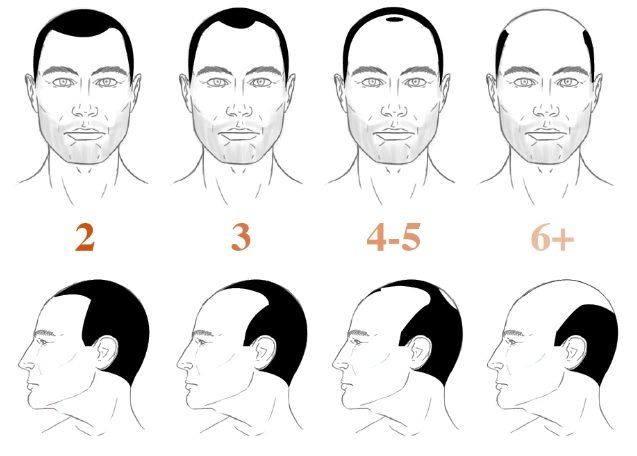The Norwood-Hamilton scale, sometimes known as the "Norwood Scale," was developed by doctor James Hamilton to assess the phases of male pattern baldness in the 1950s. Dr. O'tar Norwood made significant improvements to the scale in the 1970s. According to the Norwood scale, there are seven phases of baldness, with several models for each kind. Each level has a regular and a class A pattern. The Norwood Scale not only recognizes the progression of these patterns but also aids in classifying the phases of male pattern baldness.
Regular pattern
A bald spot on the head's crown and temples signals the beginning of a regular pattern.
Class A pattern
There is no bald patch on your crown region, and Class A baldness develops differently, with the hairline retreating from the front to the rear (vertex).
Norwood-Hamilton Scale stages
Stage 1
If you are at Norwood Hamilton Scale stage 1 there is nothing to worry about. Stage 1, often known as the control stage, does not show any indications of hair regrowth. You could see that the only recessions on your temporal sides are slight ones.
Stage 2
In stage 2, hair thinning may be hardly noticeable and tends to affect your temporal regions. You are likely at stage 2 if you feel that your temporal regions are receding and that your hair is becoming sparser.
Stage 3
Stage 3 is perhaps the first stage of recession, and it is extremely noticeable around the temples. Thus, at Stage 3, hair loss becomes apparent. At this stage, your hairline begins to move away from your temples and takes on a "M" shape.
Stage 3 Vertex
Your hairline resembles stage 2 in Norwood Stage 3 Vertex, but the top of your head (the vertex) seems to be losing hair.
Stage 4
In this stage, the hairline recession is more severe. Your frontal recession is more severe, and your hair creates a "U" shape. You may have scant or no hair on your crown area.
Stage 5
In Norwood Stage 5, the crown region and forehead line see noticeable hair loss. Between the front and crown region, this pattern contains a specific quantity of hair. In contrast to the previous stage, the hair is now thinner and the line is getting narrower. The hair on the head has a horseshoe form.
Stage 6
The contrast between the front and the crown has almost completely vanished by the sixth stage of hair loss. There may still be hair on the sides of the head. However, the majority of the hair is gone and the remaining hair looks to be dispersing on both sides.
Stage 7
Norwood The severity of baldness reaches an excessive and severe level by stage 7, which is the final stage of hair loss. Hair loss starts to badly harm the side of the head and leaves the ears and neck hairless. The hair that does develop will probably be brittle and thin.
Why do men lose hair in a pattern?
The most frequent cause of hair loss in males is called androgenetic alopecia (AGA). Common names for it include manly hair loss, typical baldness, and male pattern baldness. This form of hair loss begins on both sides of the head and is caused by the conversion of testosterone, the most prevalent androgenic hormone, to dihydrotestosterone by the 5-alpha-reductase enzyme in our hair follicles and by the efficient reaction of our hair follicles (bitemporal). The mid-front line then experiences spills. Miniaturization is the term for the thinning that occurs throughout this process, which causes the hair to go from having thick, strong roots to tiny, scarcely perceptible baby hair. Permanent loss will result if it is not addressed by therapy at this time.
Treatment for Hair Loss
There are several options available to you if you are experiencing hair loss, and early treatment for hair loss is the most beneficial. Let's examine some of the options that might help you.
Minoxidil
Initially, individuals with blood pressure disorders were treated with minoxidil's active component to control their blood pressure. Although the mechanism by which it promotes hair growth is still not fully known, it has FDA (U.S. Food and Drug Administration) clearance for the treatment of androgenetic hair loss. In around 60% of the patients who use it topically, the hair loss has been shown to have ceased. When people quit using Minoxidil, they typically experience more severe hair loss than they had previously. The medicine is advised to be used continuously for this reason.
Finasteride
Another useful drug for treating male pattern baldness is finasteride (Propecia). Does finasteride reduce hair thinning? It does, indeed! It promotes hair growth in the scalp's crown and temple regions.
The accuracy of the Norwood-Hamilton Scale
The Hamilton-Norwood scale is used to categorize the phases of male pattern baldness. The stages are identified by a number between 1 and 7.
My hairline should begin where?
Our primary goal as a member of the Tolan Health Hair Clinic family is naturalness. As a result, while designing, we stick to your natural hairline and avoid your forehead muscles. We suggest going natural. Additionally, we value the expectations of our patients. So, don't be alarmed! We'll help you choose the hair transplant that meets your needs best!
© Copyright 2022

